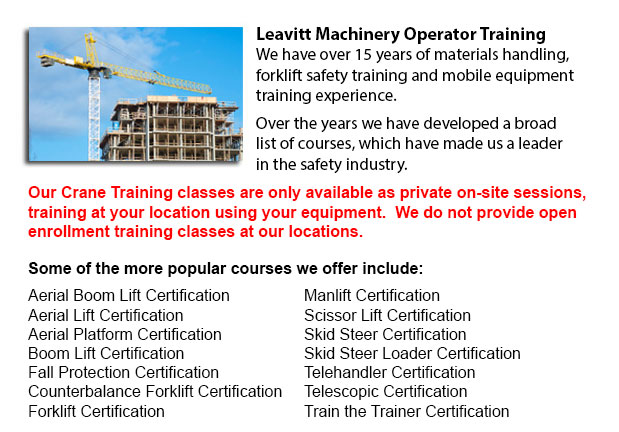
Saskatoon Overhead Crane Operator Training - The program teaching overhead crane operator training has been intended specially to instruct trainees on the basics of pre-shift checks and overhead crane/sling operation. The programs are instructed by professional trainers and consultants. Well-trained staff are more productive and efficient, which really saves on costs connected with product damage, property damage, and accidents due to the use of incorrect operating procedures. Our overhead crane certification is customized for staff who have literacy barriers, reducing certification time by 50 percent.
Overhead cranes are best for specific repetitive lifting activities. This type of crane has wide ranging capacities. They could be used for specialized lifting tasks like removing or installing major plant equipment.
In order to safely utilize an overhead crane, personnel should employ safe rigging practices. This requires both practice and knowledge. The load must be rigged properly in order to guarantee its stability when hoisted. Prior to beginning a lifting task, it must be determined that the crane is suitable for the job, with correct capacity, travel and lift. The crane should be subjected to a thorough physical and visual inspection before utilization. The capacity of all machines, including the slings, hardware and rope, should never go over load weight capacities.
The rigger must know the correct sling for every lift and inspect slings and other rigging hardware prior to using. Clear signals have to be used in communications with the crane operator. A signaler has to be chosen for the role and signals need to be agreed upon. The crane operator must follow instructions from the designated individual only. If a wired or remote controller is being utilized, the operator should be trained in all its functions.
To guarantee the safety of workers, a warning must be issued and the path of the load should be cleared of all hazards before the lift starts. Individuals must not be allowed to walk under the lift loads. The crane hoist needs to be centered over the load prior to lifting to prevent swinging. The safety catch must be closed instantly after sliding the sling entirely onto the hoisting hook. Unused sling legs should be secured so they do not drag. Never leave loose materials on a load being hoisted. Watch that hands and fingers are clear when slack is taken out of a sling. Before the lift is carried out, step clear of the danger zone.
-
Saskatoon Telehandler License
Saskatoon Telehandler License - The telescopic handler or telehandler is a frequently utilized machine in agricultural and industrial applications. This particular equipment is similar in appearance to a forklift and even functions in a similar way,... More -
Saskatoon Zoom Boom Ticket
Saskatoon Zoom Boom Ticket - Zoom Boom Training focuses on correctly training prospective operators on variable reach forklifts. The training objectives consist of gaining the knowledge of the machine's physics and to define the job of the operator.... More -
Saskatoon Forklift Operator Training
Saskatoon Forklift Operator Training - In North America, lift truck operator training is needed in order to prevent workplace injuries and accidents. Particular lift truck training will be provided to offer forklift operators driver training. The saf... More -
Saskatoon Forklift Certification Schools
Saskatoon Forklift Certification Schools - Forklift Certification is mandatory in North America. Hence, forklift training programs are essential both for businesses and for individuals seeking jobs in industries as forklift operators. Forklift traini... More -
Saskatoon Telehandler Training Courses
Saskatoon Telehandler Training Courses - Employers are responsible for making certain that their operating personnel and supervisors are trained to work competently utilizing telehandler machines. The competence level of staff must be assessed. If de... More -
Saskatoon Boom Lift Training
Saskatoon Boom Lift Training - Aerial platforms or likewise known as elevated work platforms are devices that enable workers to perform tasks and duties at elevated heights that will not be otherwise accessible. There are many aerial lifts available... More -
Crane / Overhead Crane / Self-Erect Crane / Truck Mounted Crane / Hydraulic Cranes Training in Saskatoon
Overhead cranes are likewise referred to as bridge cranes. They are a type of crane which comprises a line and hook device that runs along a horizontal beam which runs along two widely separated rails. Several overhead cranes can be found within a lo... More -
Saskatoon Heavy Equipment Training Programs
Saskatoon Heavy Equipment Training Programs - At any given construction site, there are usually different types of machinery which are ready to be used. These light and heavy machinery require both operators to run them and mechanics to fix them. Tra... More

Forklift Certification Saskatoon
TOLL FREE: 1-888-254-6157
Saskatoon, Saskatchewan
forkliftcertificationsaskatoon.com
Email Us
About Us


